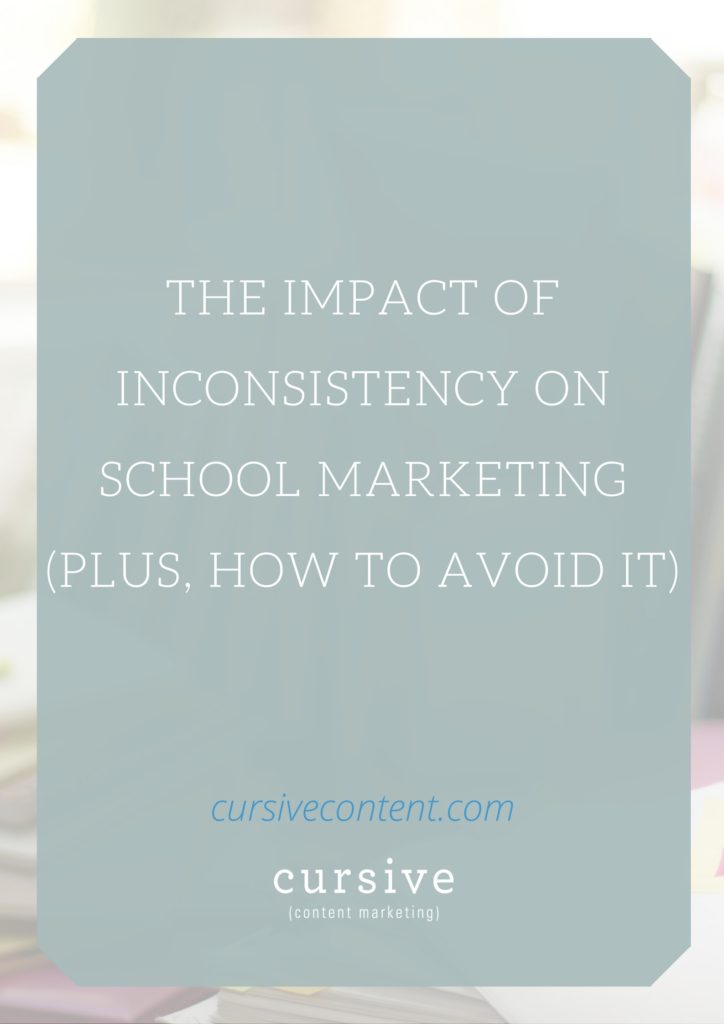The Impact of Inconsistency on School Marketing (Plus, How to Avoid it)
School marketing is a science.
And I say that not because there is some magical formula or combination of elements that create the same results every single time. No, that would be too easy.
It’s a science because it requires educated guesses, refinements and discovery. Because the work you do is always built on the work of those who have come before you, who have tried (and maybe failed) to make progress. Because while we can hold some things to be universally true, there are always new and changing variables that alter the dynamics.
When you’re in a season of re-evaluating your marketing, you might feel less “scholarly scientist” and more “mad scientist”. When you’re in the process of growing, changing and moving your marketing to the next level, there’s one emotion you’re guaranteed to feel: overwhelm.
Once marketers start learning more about modern ways to market their school, they think they have to do it all. And that’s when they start to feel like they have an elephant sitting on their chest.
We like to help people bypass that feeling by saying up front: It’s unrealistic to think you can do everything. Grand, all-or-nothing commitments sound great, but are typically not sustainable.
When it comes to your school’s marketing, if you don’t consider a workload that fits within your capacity, you’re bound to become inconsistent in your efforts. And inconsistency kills success.

When you’re inconsistent, your audience can’t rely on you.
Content is a commitment you make to your audience. If you don’t maintain your website, blog, social media, emails, etc. on a consistent basis, everything changes for your audience. They’ll forget why they wanted to hear from you in the first place, they might see you as flaky and unreliable, they’ll feel disregarded.
Not exactly the impression you want to give.
Solve it: Think about frequency and consistency separately. It is possible to start with a low frequency of content but still maintain consistency. Develop a realistic schedule and set the expectation with your audience (for example: add a note to your blog that you publish once a week, mention that your email is monthly). You can work on increasing frequency in the future.
Inconsistency makes YOU frustrated.
Frustration first appears because you’ve given yourself a to-do list you cannot possibly keep up with.
So you slow down. Then, you become frustrated because things aren’t moving as fast as you hoped. Overwhelm creeps back in, even though you’re doing less.
At this point, instead of scaling back, many marketers give up and revert to the old status quo.
Solve it: When you become frustrated, reevaluate rather than throwing in the towel. Ask for help, break big projects down into smaller phases, set priorities. Determine how you can achieve a few small successes; they’ll give you the motivation to keep moving forward. It often helps to:
- Evaluate your resources and capacity
- Develop a realistic schedule based on those resources
- Create a series of small, achievable goals
- Track meaningful data
Inconsistency gives you messed-up metrics.
There’s an interesting thought pattern that tends to follow inconsistency that stems from overwhelm. We start to convince ourselves that our lack of results from the meek efforts we’re putting forth are an indication of the efficacy of our tactic, not our effort.
Success takes time and devotion, but it’s easy to slip into a different thought pattern: “I rewrote our home page and haven’t seen a change in traffic at all. It’s not worth the effort to redo the entire site.” or “I’m sending enewsletters that no one is reading. I don’t think I should waste my time.”
It’s much easier to look at the metrics and convince yourself that the tactic you’ve chosen isn’t working than it is to realize that success and change aren’t as easy as hitting publish or send.
Solve it: The problem might not be what you’re doing, but the momentum you have yet to build. If you’ve been wishy-washy with your efforts, you can’t blame the tactics without first being honest about the implementation of those tactics. Don’t stress yourself out by placing blame, just be honest. What’s not working, and what would you need to do to make it work? How can you change an unrealistic situation into an approach you can implement? How much time do you need to truly be able to measure success? Once you determine a schedule that works and you get into the groove, take another look at the analytics. The stronger numbers will be there.

Before you burn out, reevaluate.
Starting big might work for some schools, but it’s okay if the do-it-all approach doesn’t work for you. Starting with one or two new initiatives is better than none—and it can also be better than ten, because you’ll have the motivation, energy and capacity to do each thing well.
You can start small and still be on your way to something big.
For more actionable advice and tips that support your school marketing dreams, sign up for our weekly emails using the form below.
MORE ARTICLES
-
 Clarity in 50 Words or Less: How to Write Your School’s One-Sentence Story
Clarity in 50 Words or Less: How to Write Your School’s One-Sentence Story -
 What Should Your School Do with Its Blog Now That AI Is Changing Search?
What Should Your School Do with Its Blog Now That AI Is Changing Search? -
 What Is Your Private School’s Bold & Unifying Big Promise?
What Is Your Private School’s Bold & Unifying Big Promise? -
 AI Writing Prompts to Power Private School Storytelling
AI Writing Prompts to Power Private School Storytelling -
 When to Outsource Your Private School Content Marketing to an Expert
When to Outsource Your Private School Content Marketing to an Expert -
 3 Unique Ways to Attract Dream Families with Content
3 Unique Ways to Attract Dream Families with Content -
 4 Quick & Easy Ways to Improve Your School’s Emails
4 Quick & Easy Ways to Improve Your School’s Emails -
 The Best Content Marketing Resources for Independent Schools
The Best Content Marketing Resources for Independent Schools